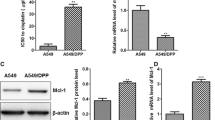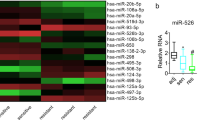Abstract
Platinum-based chemotherapies have long been used as a standard treatment in non-small cell lung cancer. However, cisplatin resistance is a major problem that restricts the use of cisplatin. Deregulated cell death mechanisms including apoptosis and autophagy could be responsible for the development of cisplatin resistance and miRNAs are the key regulators of these mechanisms. We aimed to analyse the effects of selected miRNAs in the development of cisplatin resistance and found that hsa-miR-15a-3p was one of the most significantly downregulated miRNAs conferring resistance to cisplatin in Calu1 epidermoid lung carcinoma cells. Only hsa-miR-15a-3p mimic transfection did not affect cell proliferation or cell death, though decreased cell viability was found when combined with cisplatin. We found that induced expression of hsa-miR-15a-3p via mimic transfection sensitised cisplatin-resistant cells to apoptosis and autophagy. Our results demonstrated that the apoptosis- and autophagy-inducing effects of hsa-miR-15a-3p might be due to suppression of BCL2, which exhibits a major connection with cell death mechanisms. This study provides new insights into the mechanism of cisplatin resistance due to silencing of the tumour suppressor hsa-miR-15a-3p and its possible contribution to apoptosis, autophagy and cisplatin resistance, which are the devil’s triangle in determining cancer cell fate.








Similar content being viewed by others
References
Dasari S, Tchounwou PB. Cisplatin in cancer therapy: molecular mechanisms of action. Eur J Pharmacol. 2014;740:364–78. doi:10.1016/j.ejphar.2014.07.025.
Chen Y, Fu LL, Wen X, Liu B, Huang J, Wang JH, et al. Oncogenic and tumor suppressive roles of microRNAs in apoptosis and autophagy. Apoptosis. 2014;19(8):1177–89. doi:10.1007/s10495-014-0999-7.
Fu LL, Wen X, Bao JK, Liu B. MicroRNA-modulated autophagic signaling networks in cancer. Int J Biochem Cell Biol. 2012;44(5):733–6. doi:10.1016/j.biocel.2012.02.004.
Cecconi F. Autophagy regulation by miRNAs: when cleaning goes out of service. EMBO J. 2011;30(22):4517–9. doi:10.1038/emboj.2011.387.
Joshi P, Middleton J, Jeon YJ, Garofalo M. MicroRNAs in lung cancer. World J Methodol. 2014;4(2):59–72. doi:10.5662/wjm.v4.i2.59.
Calin GA, Dumitru CD, Shimizu M, Bichi R, Zupo S, Noch E, et al. Frequent deletions and down-regulation of micro-RNA genes miR15 and miR16 at 13q14 in chronic lymphocytic leukemia. Proc Natl Acad Sci U S A. 2002;99(24):15524–9. doi:10.1073/pnas.242606799.
Lin K, Farahani M, Yang Y, Johnson GG, Oates M, Atherton M, et al. Loss of MIR15A and MIR16-1 at 13q14 is associated with increased TP53 mRNA, de-repression of BCL2 and adverse outcome in chronic lymphocytic leukaemia. Br J Haematol. 2014;167(3):346–55. doi:10.1111/bjh.13043.
Cimmino A, Calin GA, Fabbri M, Iorio MV, Ferracin M, Shimizu M, et al. miR-15 and miR-16 induce apoptosis by targeting BCL2. Proc Natl Acad Sci U S A. 2005;102(39):13944–9. doi:10.1073/pnas.0506654102.
Yang Z, Klionsky DJ. Eaten alive: a history of macroautophagy. Nat Cell Biol. 2010;12(9):814–22. doi:10.1038/ncb0910-814.
Klionsky DJ, Abeliovich H, Agostinis P, Agrawal DK, Aliev G, Askew DS, et al. Guidelines for the use and interpretation of assays for monitoring autophagy in higher eukaryotes. Autophagy. 2008;4(2):151–75.
Apel A, Zentgraf H, Buchler MW, Herr I. Autophagy—a double-edged sword in oncology. Int J Cancer. 2009;125(5):991–5. doi:10.1002/ijc.24500.
Ito H, Daido S, Kanzawa T, Kondo S, Kondo Y. Radiation-induced autophagy is associated with LC3 and its inhibition sensitizes malignant glioma cells. Int J Oncol. 2005;26(5):1401–10.
Ertmer A, Huber V, Gilch S, Yoshimori T, Erfle V, Duyster J, et al. The anticancer drug imatinib induces cellular autophagy. Leukemia. 2007;21(5):936–42. doi:10.1038/sj.leu.2404606.
Chen N, Debnath J. Autophagy and tumorigenesis. FEBS Lett. 2010;584(7):1427–35. doi:10.1016/j.febslet.2009.12.034.
Solly K, Wang X, Xu X, Strulovici B, Zheng W. Application of real-time cell electronic sensing (RT-CES) technology to cell-based assays. Assay Drug Dev Technol. 2004;2(4):363–72. doi:10.1089/1540658041850544.
Kabeya Y, Mizushima N, Ueno T, Yamamoto A, Kirisako T, Noda T, et al. LC3, a mammalian homologue of yeast Apg8p, is localized in autophagosome membranes after processing. EMBO J. 2000;19(21):5720–8. doi:10.1093/emboj/19.21.5720.
He H, Dang Y, Dai F, Guo Z, Wu J, She X, et al. Post-translational modifications of three members of the human MAP1LC3 family and detection of a novel type of modification for MAP1LC3B. J Biol Chem. 2003;278(31):29278–87. doi:10.1074/jbc.M303800200.
MacDonagh L, Gray SG, Finn SP, Cuffe S, O’Byrne KJ, Barr MP. The emerging role of microRNAs in resistance to lung cancer treatments. Cancer Treat Rev. 2015;41(2):160–9. doi:10.1016/j.ctrv.2014.12.009.
Bursch W, Hochegger K, Torok L, Marian B, Ellinger A, Hermann RS. Autophagic and apoptotic types of programmed cell death exhibit different fates of cytoskeletal filaments. J Cell Sci. 2000;113(Pt 7):1189–98.
Kang R, Wang ZH, Wang BQ, Zhang CM, Gao W, Feng Y, et al. Inhibition of autophagy-potentiated chemosensitivity to cisplatin in laryngeal cancer Hep-2 cells. Am J Otolaryngol. 2012;33(6):678–84. doi:10.1016/j.amjoto.2012.05.005.
Wang J, Wu GS. Role of autophagy in cisplatin resistance in ovarian cancer cells. J Biol Chem. 2014;289(24):17163–73. doi:10.1074/jbc.M114.558288.
Yu L, Gu C, Zhong D, Shi L, Kong Y, Zhou Z, et al. Induction of autophagy counteracts the anticancer effect of cisplatin in human esophageal cancer cells with acquired drug resistance. Cancer Lett. 2014;355(1):34–45. doi:10.1016/j.canlet.2014.09.020.
Bao L, Jaramillo MC, Zhang Z, Zheng Y, Yao M, Zhang DD, et al. Induction of autophagy contributes to cisplatin resistance in human ovarian cancer cells. Mol Med Rep. 2015;11(1):91–8. doi:10.3892/mmr.2014.2671.
Sirichanchuen B, Pengsuparp T, Chanvorachote P. Long-term cisplatin exposure impairs autophagy and causes cisplatin resistance in human lung cancer cells. Mol Cell Biochem. 2012;364(1–2):11–8. doi:10.1007/s11010-011-1199-1.
Aqeilan RI, Calin GA, Croce CM. miR-15a and miR-16-1 in cancer: discovery, function and future perspectives. Cell Death Differ. 2010;17(2):215–20. doi:10.1038/cdd.2009.69.
Druz A, Chen YC, Guha R, Betenbaugh M, Martin SE, Shiloach J. Large-scale screening identifies a novel microRNA, miR-15a-3p, which induces apoptosis in human cancer cell lines. RNA Biol. 2013;10(2):287–300. doi:10.4161/rna.23339.
Chen F, Hou SK, Fan HJ, Liu YF. MiR-15a-16 represses Cripto and inhibits NSCLC cell progression. Mol Cell Biochem. 2014;391(1-2):11–9. doi:10.1007/s11010-014-1981-y.
Tafsiri E, Darbouy M, Shadmehr MB, Zagryazhskaya A, Alizadeh J, Karimipoor M. Expression of miRNAs in non-small-cell lung carcinomas and their association with clinicopathological features. Tumour Biol. 2014. doi:10.1007/s13277-014-2755-6.
Lan F, Yue X, Ren G, Li H, Ping L, Wang Y, et al. iR-15a/16 enhances radiation sensitivity of non-small cell lung cancer cells by targeting the TLR1/NF-kappaB signaling pathway. Int J Radiat Oncol Biol Phys. 2014. doi:10.1016/j.ijrobp.2014.09.021.
Zhang C, Fang X, Li W, Shi Q, Wu L, Chen X, et al. Influence of recombinant lentiviral vector encoding miR-15a/16-1 in biological features of human nasopharyngeal carcinoma CNE-2Z cells. Cancer Biother Radiopharm. 2014;29(10):422–7. doi:10.1089/cbr.2013.1596.
Sanchez-Beato M, Sanchez-Aguilera A, Piris MA. Cell cycle deregulation in B-cell lymphomas. Blood. 2003;101(4):1220–35. doi:10.1182/blood-2002-07-2009.
Lindqvist LM, Vaux DL. BCL2 and related prosurvival proteins require BAK1 and BAX to affect autophagy. Autophagy. 2014;10(8):1474–5. doi:10.4161/auto.29639.
Pattingre S, Levine B. Bcl-2 inhibition of autophagy: a new route to cancer? Cancer Res. 2006;66(6):2885–8. doi:10.1158/0008-5472.CAN-05-4412.
Coker-Gurkan A, Arisan ED, Obakan P, Ozfiliz P, Kose B, Bickici G, et al. Roscovitine-treated HeLa cells finalize autophagy later than apoptosis by downregulating Bcl2. Mol Med Rep. 2015;11(3):1968–74. doi:10.3892/mmr.2014.2902.
Akar U, Chaves-Reyez A, Barria M, Tari A, Sanguino A, Kondo Y, et al. Silencing of Bcl-2 expression by small interfering RNA induces autophagic cell death in MCF-7 breast cancer cells. Autophagy. 2008;4(5):669–79.
Kapuy O, Vinod PK, Mandl J, Banhegyi G. A cellular stress-directed bistable switch controls the crosstalk between autophagy and apoptosis. Mol BioSyst. 2013;9(2):296–306. doi:10.1039/c2mb25261a.
Cetintas VB, Kucukaslan AS, Kosova B, Tetik A, Selvi N, Cok G, et al. Cisplatin resistance induced by decreased apoptotic activity in non-small-cell lung cancer cell lines. Cell Biol Int. 2012;36(3):261–5. doi:10.1042/CBI20110329.
Kang MH, Reynolds CP. Bcl-2 inhibitors: targeting mitochondrial apoptotic pathways in cancer therapy. Clin Cancer Res. 2009;15(4):1126–32. doi:10.1158/1078-0432.CCR-08-0144.
Chen CQ, Chen CS, Chen JJ, Zhou LP, Xu HL, Jin WW, et al. Histone deacetylases inhibitor trichostatin A increases the expression of Dleu2/miR-15a/16-1 via HDAC3 in non-small cell lung cancer. Mol Cell Biochem. 2013;383(1-2):137–48. doi:10.1007/s11010-013-1762-z.
Bandi N, Zbinden S, Gugger M, Arnold M, Kocher V, Hasan L, et al. miR-15a and miR-16 are implicated in cell cycle regulation in a Rb-dependent manner and are frequently deleted or down-regulated in non-small cell lung cancer. Cancer Res. 2009;69(13):5553–9. doi:10.1158/0008-5472.CAN-08-4277.
Gao SM, Yang J, Chen C, Zhang S, Xing CY, Li H, et al. miR-15a/16-1 enhances retinoic acid-mediated differentiation of leukemic cells and is up-regulated by retinoic acid. Leuk Lymphoma. 2011;52(12):2365–71. doi:10.3109/10428194.2011.601476.
Acknowledgments
This study was supported by the Ege University Research Fund [grant number BAP-2013-TIP-049 (to V.B.Ç.)]. The authors wish to thank Oguz Gözen (Department of Physiology, Ege University Medical Faculty) for proofreading and major contributions to the manuscript.
Conflicts of interest
None
Author information
Authors and Affiliations
Corresponding author
Rights and permissions
About this article
Cite this article
Bozok Çetintaş, V., Tetik Vardarlı, A., Düzgün, Z. et al. miR-15a enhances the anticancer effects of cisplatin in the resistant non-small cell lung cancer cells. Tumor Biol. 37, 1739–1751 (2016). https://doi.org/10.1007/s13277-015-3950-9
Received:
Accepted:
Published:
Issue Date:
DOI: https://doi.org/10.1007/s13277-015-3950-9




